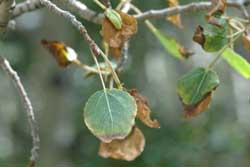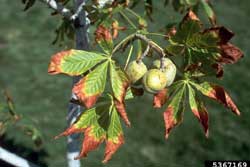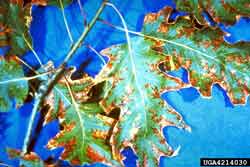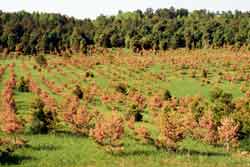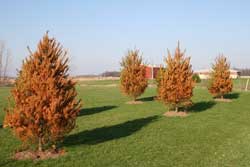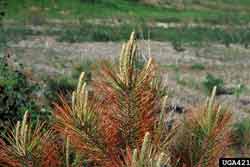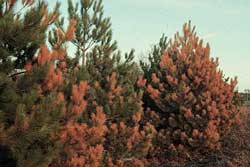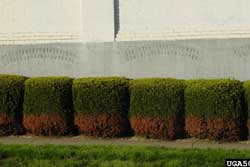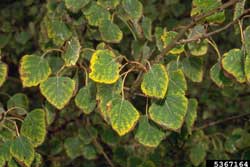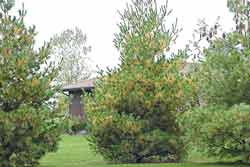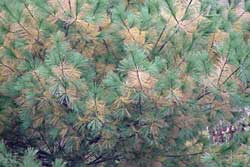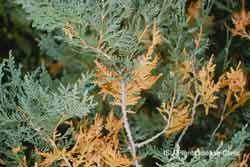Other Problems of Trees and Shrubs
Leaf Scorch/Sunscald
Leaf scorch is a result of stress on the plant. This can be caused by a number of factors, including soil compaction, chemical injury, poor soil, unfavorable weather conditions (such as drought) or limited room for root growth. Symptoms include yellowing and/or darkening of tissues between the main leaf veins or along the leaf margins.
Winter Drying
Winter desiccation occurs when winter sun and wind cause excessive water loss from the twigs and leaves, while roots in frozen soil are unable to replace it. The problem is most often associated with evergreens.
Salt Damage
Salt damage occurs in three ways: 1) Salt sprayed directly on the plant makes the plant lose cold hardiness and become susceptible to freezing; 2) Salt accumulation in the soil absorbs water, making it unavailable to plants; and 3) Chloride ions are absorbed by the roots, transported to the leaves, and accumulate there to toxic levels - it is these toxic levels that cause the characteristic marginal leaf scorch. Evergreens are particularly sensitive to salt damage.
Natural Fall Conifer Needle Drop
Needles of conifers have varying life spans–eventually they will turn brown, and fall off, just not all at once like deciduous trees. Typically white pine needles live for three years, which means that each year 1/3 of a trees needles will die. Spruce trees generally hold their needles for 5-7 years.
Click on images to view full-size
Identification and Control Information
- Leaf Scorch of Trees and Shrubs (PDF)—Purdue University Extension
- Leaf Scorch and Winter Drying of Woody Ornamentals (PDF)—University of Kentucky Cooperative Extension Service
- Winter Drying—Maine Forest Service
- Winter Desiccation Injury (PDF)
- Winter Injury to Trees and Shrubs (PDF)—Cornell University Cooperative Extension
- Salt Damage in Landscape Plants (PDF)—Purdue University Extension
- Tree Susceptibility to Salt Damage (PDF)—University of Tennesee Agricultural Extension Service
- Minimizing De-Icing Salt Injury to Trees—University of Minnesota Extension
- Fall Conifer Needle Loss (PDF)—Missouri State University Extension
- Natural Needle Drop In Evergreens (PDF)—University of Illinois Extension
- Evergreen condition: Seasonal needle drop (PDF)—University of Wisconsin Extension
More Information
- Maine Forest Service: Conditions Reports (updated regularly) including annual summary reports
[Photos, left to right: William M. Ciesla, Forest Health Management International, Bugwood.org; Mike Schomaker, Colorado State Forest Service, Bugwood.org; Minnesota Department of Natural Resources Archive, Minnesota Department of Natural Resources, Bugwood.org; Linda Haugen, USDA Forest Service, Bugwood.org; Purdue University Extension; Minnesota Department of Natural Resources Archive, Minnesota Department of Natural Resources, Bugwood.org; University of Minnesota Extension; Joseph LaForest, University of Georgia, Bugwood.org; William Jacobi, Colorado State University, Bugwood.org; Purdue University Plant and Pest Digital Library Project; Purdue University Plant and Pest Digital Library Project; Iowa State University of Science and Technology]
